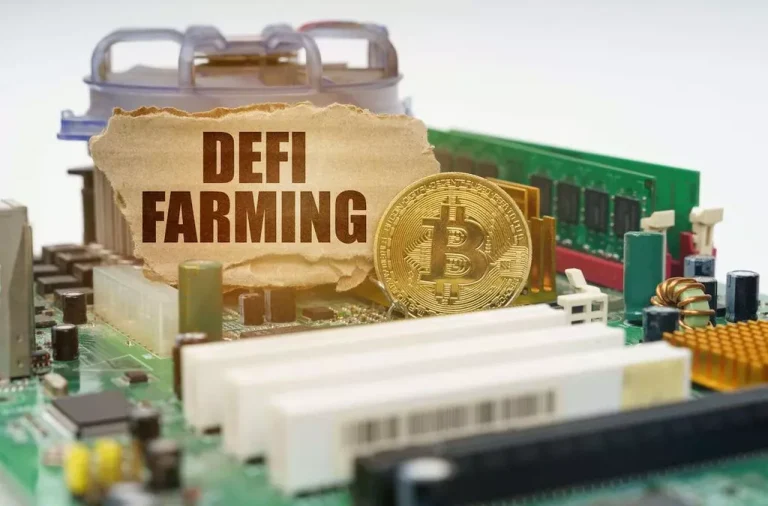Less than ten years have passed since the crypto universe shook the world. The newest trend is decentralized finance, which finds its application in virtual money. This system is capable of growth, as we have seen since the $4 billion Total Value Locked (TVL) spike in DeFi. Even despite the crypto volatility, such a system brings its benefits. As an illustration, companies are creating more DeFi yield farming crypto projects. It is an excellent way to transform conventional financial products that operate on transparent protocols without intermediaries.
Even though the concept appears clear at first, DeFi yield farming development raises several noteworthy issues and challenges. One of them is figuring out how to create a platform that would allow the “cryptocurrency crop” to flourish.
What is Yield Farming?
A set of instruments and techniques recognized as “yield farming” lets you profit from digital assets by utilizing DEX protocols. It works very simply. DeFi users rent out their coins or tokens, for which they receive a reward defined in the protocols. After all, each ecosystem member can use money, borrowing it with a margin. Or, they can take on the role of liquidity. This facilitates trading in the case of a DEX powered by an automated market maker.
With the release of the Ethereum platform in 2015, which popularized smart contracts, there was the possibility to establish a decentralized financial market. It made it possible to develop independent decentralized apps like AMM, boarding protocols, and DEX exchanges.
Every task in YF is dependent on smart contracts. The two primary approaches to DeFi farm are lending and liquidity mining. When we talk about the first instance, the owner charges a fee to another trader to rent out his crypto.
Liquidity mining is about the holder giving traders liquidity for a reward. Instead of merely holding virtual currency in your wallet, these techniques enable you to use it to make extra money.
Holders turn into liquidity suppliers and block a portion of their holdings in a smart contract in order to increase the revenue they get from their coins. However, at first, the sole sources of revenue were fees from swaps on DEXs or interest that borrowers paid.
According to reports, this sector is flourishing, and investors have made up to 50% returns in 2021. As Forbes experts quite rightly acknowledge, all it takes to profit from YF is the appropriate underlying platform and time.


Turnkey Brokerage Solution For Your Business
Get the most profitable fully licensed fx/crypto brokerage software or ready-to-operate business in 48 hours. Best-in-class web & mobile trading platforms, sales-driven CRM, full integration with MT4/5, and 150+ payment providers.
Types Of DeFi Yield Farming
There are several methods for how lenders might generate returns from the tokens they set in the LP. Let’s examine one of the most sought-after forms of YF.
Interest on the lending deposits
Depositing tokens into a farming pool or particular account run by computer systems lets members earn interest on their contributions. They obtain unique tokens that accrue interest in exchange for this.
Transaction fees for offering liquidity
Making your coin tradable on decentralized exchanges (DEX) is another method to increase DeFi’s profitability. Exchange platforms charge a nominal charge for exchanges, and the proceeds go to liquidity suppliers — those who supply cryptocurrency to trade — in the exchange pools.
Token incentives from protocol operators
Compound Finance and Uniswap are pushing the notion that previous and present clients of their platforms can share tokens or virtual currency. It serves as a thank-you for partaking in these initiatives and showcasing platform abilities.
Token incentives from pool operators
Let’s say a brand-new blockchain introduces its own virtual money. It’s new, therefore, not many people are interested in buying or selling it. As a result, the creators draw in users who trade other coins for their digital cash. They provide these individuals with extra perks in exchange for their currencies.

What is the Difference between Yield Farm, Liquidity Mining, and Staking?
It is pivotal to clarify yield farming vs staking are distinctive terms, even though both involve consumers contributing their virtual coins in exchange for a fixed income.
Staking is considered the securest option when all other factors are taken into account. It’s due to the fact that you store assets in the wallet here. With YF and liquidity mining, you get more risks as you transfer tokens between other liquidity pools.
Additionally, staking may result in a lesser return. Because YF entails shifting your holdings across various liquidity pools to get the highest return on investment, it provides better returns than staking. Moreover, because liquid mining gives a certain coin liquidity to boost it, you may anticipate making the most money from it.
Staking is, after all, a more transparent and intelligible procedure. However, because they require transferring holdings between several liquidity pools or adding liquidity to those pools, YF, and liquidity mining are more complicated.
Must-Have Features For The DeFi Yield Farming Platform
It’s pivotal to incorporate essential features while developing cryptocurrency yield farming software. Let’s examine a few crucial components to include in your future project.
Wallet integration
Interacting with wallets is pivotal to bringing forth a crypto-earning potential of the yield farming platforms. Integrating the wallet into the system is indispensable because when the coin enters the network, it remains on the platform. Therefore, you must ensure the safety and reliability of the storage of client funds.
Charts of Liquidity Pools
The section aims to assist borrowers and lenders in gradually boosting the entire amount of money in the pool. It lets you take into account projected income and risks. As a result, consumers have more options where to invest their money.
Swap token
It is hard to incorporate every token in the software due to the enormous quantity of virtual coins into one program. To solve the problem, a token exchange mechanism must be developed so lenders may swap the coins for those accepted by the platform.
Deposit and Withdraw
It is difficult to imagine a yield farming app that does not offer its users to safely deposit and withdraw funds. Users can benefit from this feature to put money into the platform and withdraw profits when they reach a target rate. Therefore, you should definitely include it in the project.
The Process of DeFi Yield Farming Platform Development
Coming up with a DeFi yield farming platform is the same as doing any digital finance project. Let’s dwell on the top vital steps to take on your way to designing a best-in-class product:
- In this first phase, the product’s objectives, capabilities, and methods of operation are specified. Likewise, it applies to the selection of solution stack. To comprehend the customer’s demands and connect them to technological solutions, business analysts must maintain regular communication with them.
- Another vital DeFi yield farming development stage is design. The inadequate UI of many DeFi systems is an alerting issue. Get seasoned creators on board so that they assist you in developing not just a stunning UI but also strategies to showcase the product’s positive sides.
- The DeFi yield farming development sets off once you understand how the platform must operate, what benefits users should receive, and what functions it should have. The fundamental components of DeFi products are unique, automatically running applications. Since these apps must be effective and safe from attacks, developing them requires an in-depth understanding of the blockchain. Considering the fact that hackers frequently target DeFi protocols, smart contract safety is necessary.
- The product has to be tested to find bugs before it is released. Testing includes determining how a product functions and how it is used. Another step is to validate smart contracts prior to bringing them to market. This involves carefully examining the code to spot errors and weak points.
It’s critical that you invest time and attention into every aspect of YF product development. Programmers may guarantee the incorporation of crucial features like token exchange capabilities, staking incentives, liquidity pools, strong security measures, and all yield farming tools by adhering to the guidelines. With these components, the app may tap potential revenues in a decentralized financial ecosystem while offering customers a seamless and secure experience.






